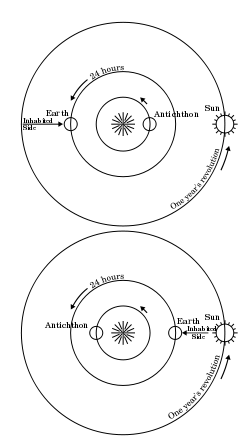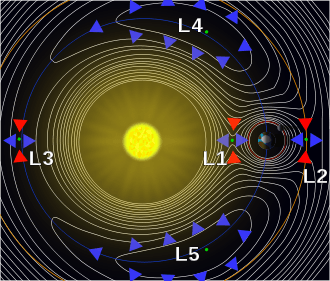Counter-Earth
The Counter-Earth is a hypothetical body of the Solar system hypothesized by the pre-Socratic philosopher Philolaus (c. 470 – c. 385 BCE) to support his non-geocentric cosmology, in which all objects in the universe revolve around an unseen "Central Fire" (distinct from the Sun which also revolves around it). The Greek word Antichthon (Greek: Ἀντίχθων) means "Counter-Earth."
In modern times a hypothetical planet always on the other side of the Sun from the Earth has been called a "Counter-Earth",[1] and has been a recurring theme in fiction, science fiction[2] and UFO claims.[3]
Greek Pythagorean universe

In the 5th century BC an astronomical system positing that the Earth, Moon, Sun and planets revolve around an unseen "Central Fire" was developed, attributed to the Pythagorean[5] philosopher Philolaus. Philolaus' universe had the Sun revolving around the Central Fire, and included a nonexistent "Counter-Earth" in his system, moving "the earth from the center of the cosmos",[6] and provided the insight that "the apparent motion of the heavenly bodies" was (in large part) due to "the real motion of the observer"—i.e. Earth.[7]
In Philolaus's system, the Earth did not rotate and its inhabited surface faced away from the Central Fire—possibly because it was flat. The revolution of the Earth around the Central Fire was not yearly but daily, while the Moon's revolution was monthly, and the sun's yearly. It was the Earth's speedy travel past the slower moving Sun that resulted in the appearance on Earth of the Sun rising and setting. Further from the Central Fire, the Planets' movement was slower still, and the outermost "sky" (i.e. stars) probably fixed.[6]
Counter-Earth
Along with the Central Fire, the "mysterious"[6] Counter-Earth (Antichthon) was the other heavenly body not visible from Earth. We know that Aristotle described it as "another Earth", from which Greek scholar George Burch infers that it must be similar in size, shape and constitution to Earth.[8] Some (astronomer John Louis Emil Dreyer) think Philolaus had it following an orbit so that it was always located between Earth and Central Fire,[9] and a tale of Greek mythology may have placed it in that location to stop man from looking at the throne of Zeus directly. However, Burch argues Philolaus must have thought it orbited on the other side of the Fire from Earth. Since "counter" means "opposite", and opposite can only be in respect to the Central Fire, it follows that the Counter-Earth must be orbiting 180 degrees from Earth.[10]
According to Aristotle — a critic of the Pythagoreans — the function of the Counter-Earth was to explain "eclipses of the moon and their frequency",[11] which could not be explained by Earth blocking the light of the sun if the Earth did not revolve around the sun. Aristotle suggests that it was also introduced "to raise the number of heavenly bodies around the central fire from nine to ten, which the Pythagoreans regarded as the perfect number" [12][13] .[7]
However Burch believes Aristotle was having a joke "at the expense of Pythagorean number theory",[7] and that the true purpose of the Counter-Earth was to "balance" Philolaus's cosmos—balance being needed because without a counter there would be only one dense, massive object in the system—Earth. Although his system had both the Earth and the Planets orbiting a single point, the ancient Greeks did not consider Earth a "Planet". In the time before Galileo could observe from his telescope that Planets were spheres like Earth, they were thought to be different from stars only in brightness and in their motion, and like stars composed of a fiery or ethereal matter having little or no density. However, the Earth was obviously made of the dense elements of earth and water. According to Burch,
"If there was a single Earth revolving at some distance from the center of space, then the universe's center of gravity, located in the Earth as its only dense body, would not coincide with its spatial center ... The universe, consequently, would be off center, so to speak—lopsided and asymmetric—a notion repugnant to any Greek, and doubly so to a Pythagorean."[14]
This could be corrected by another body with the same mass as Earth, orbiting the same central point but 180 degrees from Earth—the Counter-Earth.[7]
Later
In the 1st century A.D., after the idea of a spherical Earth gained more general acceptance, Pomponius Mela, a Latin cosmographer, developed an updated version of the idea, wherein a spherical Earth must have a more or less balanced distribution of land and water. Mela drew the first map on which the mysterious continent of Earth appears in the unknown half of Earth—our antipodes. This continent he inscribed with the name Antichthones.[15]
Modern era


The idea of a Counter-Earth did not have significant currency at least since the introduction of the heliocentric model in the 16th century. Nevertheless, as late as 1968, the Scientific Study of Unidentified Flying Objects headed by Edward Condon at the University of Colorado included a "Numerical Experiment on the Possible Existence of an 'Anti-Earth'" as an appendix. A Counter-Earth would have gravitational influence (perturbation) upon the other planets, comets and man-made probes of the Solar System.[16] No such influence has been detected, and indeed space probes sent to Venus, Mars and other places could not have successfully flown by or landed on their targets if a Counter-Earth existed, as it was not accounted for in navigational calculation. Roughly speaking, anything larger than 100 miles (160 km) in diameter should have been detected.[17] The gravitational forces of the other planets on a Counter-Earth would make its orbit unstable. Venus has 82% of the mass of Earth and would come within 0.3 Astronomical unit of the location of a Counter Earth every 20 months, providing considerable gravitational pull that over the years would move its orbit into sight of observers on Earth.[18] If a Counter-Earth was much smaller than Earth, its location at the "Sun–Earth L3" Lagrangian point (see diagram), would mean the combined gravitational pull of the two large masses of Earth and Sun would provide "precisely the centripetal force required to orbit with them". But a small planet would be even more influenced by the orbit of Venus, Mars and Jupiter, making it even more unstable.

Any planetary sized body 180 degrees from Earth should also have been visible to some space probes, such as NASA's STEREO coronagraph probes (two spacecraft launched into orbits around the Sun in 2006, one farther ahead of and one behind the Earth's orbit) which would have seen the Counter-Earth during the first half of 2007. The separation of the STEREO spacecraft from Earth would give them a view of the L3 point during the early phase of the mission.[17]
For a Counter-Earth orbiting the same path as Earth to always stay 180 degrees from Earth, the two planets would have to have circular orbits, but Earth's orbit is elliptical. Following Kepler's second law, a planet revolves faster when it is close to the star, so a Counter-Earth following the Earth on the same orbit with half a year of delay would sometimes not be exactly 180 degrees from Earth.[1] To be hidden from Earth, the Counter-Earth would have an orbit symmetrical to Earth's, not sharing the second focus or orbit path.
References in culture
The idea of a Counter-Earth has been a recurring motif in science fiction, fiction—often serving as an allegory for the real Earth[19]—and UFO claims.[3]
- Gor is the name of the Counter-Earth that is the setting for a series of 32 novels by John Norman.[20]
- The 1969 science-fiction film Doppelgänger (also known as Journey to the Far Side of the Sun), depicts the discovery and investigation of another planet sharing Earth's orbit on the opposite side of the Sun.
- Two 2011 films—Another Earth[21] and the Lars von Trier's film Melancholia—feature a plot in which a planet emerges from behind the Sun and approaches Earth.[22]
- Several Marvel Comics or spinoffs of comics were set, or had parts of a story set, in a Counter-Earth. These included The High Evolutionary, The Spider-Man Unlimited TV series and the associated comic book, Infinity Crusade: Paradise Omega, The Earth of The New Universe, and the Heroes Reborn Earth ("more of a Pocket Dimension than an actual planet"). For a more in-depth explanation of the Counter-Earth used by Marvel Comics, see Counter-Earth (comics).
- On The Adventures Of Superman radio series, the planet Krypton is said to be "situated on the other side of the Sun" from the Earth in the first episode.
- Antikhthon, a piece of music by Iannis Xenakis
See also
References
- ↑ 1.0 1.1 Comins, Neil F. (2010). What If the Earth Had Two Moons?: And Nine Other Thought-Provoking ... macmillan. pp. 171–172.
- ↑ Fictional planets of the Solar System#Counter-Earth
- ↑ 3.0 3.1 The Ufo Book of Lists| By STEPHEN J SPIGNESI, Stephen J. Spignesi|
- ↑ Source: Dante and the Early Astronomers by M. A. Orr, 1913.
- ↑ History of the Pythagorean school hosted by Drury University, Springfield, Missouri
- ↑ 6.0 6.1 6.2 Philolaus, Stanford Encyclopedia of Philosophy, Carl Huffman.
- ↑ 7.0 7.1 7.2 7.3 Burch, George Bosworth. The Counter-Earth. Osirus, vol. 11. Saint Catherines Press, 1954. p. 267-294
- ↑ Burch, 1954, p.285
- ↑ Dreyer, John Louis Emil. History of the planetary systems from Thales to Kepler. p. 42.
To complete the number ten, Philolaus created the antichthon, or counter-earth. This tenth planet is always invisible to us, because it is between us and the central fire and always keeps pace with the Earth.
- ↑ Burch, 1954, p.280
- ↑ Heath, Thomas (1981). A History of Greek Mathematics, Volume 1. Dover. p. 165.
- ↑ Arist., Metaph. 986a8–12. quoted in Philolaus, Stanford Encyclopedia of Philosophy, Carl Huffman.
- ↑ "Greek cosmology, The Pythagoreans". University of California, Riverside.
The importance of pure numbers is central to the Pythagorean view of the world. A point was associated with 1, a line with 2 a surface with 3 and a solid with 4. Their sum, 10, was sacred and omnipotent.
- ↑ Burch, 1954, p.286-7
- ↑ Pomponius Mela. de Chorographia.
- ↑ DUNCOMBE, R. L. "Appendix E. Report on Numerical Experiment on the Possible Existence of an "Anti-Earth"". 1968. U.S. NAVAL OBSERVATORY. Retrieved 24 October 2013.
At the end of 112 years the perturbations induced by Clarion [a name for the Counter-Earth] in the motions of Venus, Earth, and Mars reached 1200", 3800", and 1660" respectively.
- ↑ 17.0 17.1 Could There Be a Planet Hidden on the Opposite Side of our Sun? PopSci asks the scientist who has peered around it| By Danny Freedman| 04.20.2009
- ↑ DUNCOMBE, R. L. "Appendix E. Report on Numerical Experiment on the Possible Existence of an "Anti-Earth"". 1968. U.S. NAVAL OBSERVATORY. Retrieved 24 October 2013.
The separation of [a Counter-Earth] from the line joining the Earth and the Sun shows a variation with increasing amplitude in time, the effect being most pronounced for the largest assumed mass. During the 112 years covered by the integration the separation becomes large enough in all cases that Clarion should have been directly observed, particularly at times of morning or evening twilight and during total solar eclipses.
- ↑ Another Earth, Doppelgänger
- ↑ Zero Point: The Counter-Earth
- ↑ Rich, Katey (July 19, 2011). "'Another Earth' presents worlds of possibilities". Cinemablend.com.
a drama about what happens when a "mirror" Earth is discovered lurking behind the sun, looking exactly like our planet and containing people who are, in some strange cosmic way, twins of every single person on the planet.
- ↑ Andrea Magrath (2011-05-18). "Sunny Kirsten Dunst is picture perfect at the Cannes photocall for her provocative new film Melancholia". Daily Mail (London). Retrieved 2011-05-27.
Further reading
- The Secret Teachings of All Ages: An Encyclopedic Outline of Masonic, Hermetic, Qabbalistic and Rosicrucian Symbolical Philosophy, by Manly P. Hall, Philosophical Research Society Inc. ISBN 1-58542-250-9
- Book of Earths, by Edna Kenton, Kessinger Publishing. ISBN 0-7661-2856-3
| ||||||||||||||||||||||||||